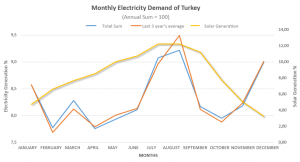 SUMMARY:
SUMMARY:
After claiming “Even with super-cheap batteries, we can’t run 100% of the world on solar just yet.”, Bloomberg New Energy Finance’s CEO, Micheal Liebreich, who is more on the optimistic side of renewable energy, has now claimed that there isn’t enough sunlight in the winter in a significant part of the northern hemisphere. In this Q report, we will seek answers to some basic questions like what the relationship between solar production and the monthly electricity demand in Turkey is, how much solar installation we will need to meet our entire consumption and how much is the seasonal imbalance.
METHOD:
Data from PV Watts program of US national renewable energy laboratories and TEİAŞ were used. Ankara was chosen through PV Watts and the remaining parameters in the system were accepted as they are. Monthly gross electricity consumption figures were derived from TEİAŞ. The reasoning behind the selection of Ankara was the expectation that a geographical balance will be established by installing solar to all regions, and Ankara will be the possible weight center of this set up. First, the AC (alternating current) generated for 1 kW panel is brought to 1 GWh. The study was then completed by calculating the ratio of monthly electricity demand to the whole year as well as the ratio of solar production to the whole year.
ANALYSIS:
A considerable chunk of solar generation takes place in the summer months. In winter months, where electricity consumption figures reach their highest, solar generation is observed to hit its lowest levels. Electricity generation may increase in these months with more wind. However, there is also no guarantee for the amount of wind.


When we look at production on an hourly basis, we see a much more intermittent solar production in the winter months. This suggests that during winter, ancillary service/storage needs will be higher than in summer months.

Supposing storage is not a problem and we have the opportunity to meet all our electricity needs with solar energy, we would need a total installed capacity of 643,900 MW in December (Turkey’s current installed capacity is around 85,000 MW). Even if all of these panels were to be installed in the sun-rich Konya region, it would not make any effectual drop in this figure’s size. On the other hand, an installed battery power, probably more than half of this figure, will also be needed. We are capable of meeting the entire demand with 179,400 MW of installed capacity in August (ie twice the size our current installed capacity), which may require an extra storage capacity of 129,000 MW. If August peak demand is assumed to be at 49,000 MW, the remaining 130,000 MW should be stored without waste. Meeting full day energy demand in August from solar and storage will require 300,000 MW of solar and storage power, which equals to an investment exceeding $300 billion. Considering that Turkey’s annual investment growth of electricity generation is around $6-7 billion, at best we will need 50 years.
CONCLUSION:
What should be the optimum ratio of solar in the system? To answer this question, more questions will have to be answered. It is evident that the imbalances of solar in winter and summer generation will have an asymmetrical effect on Turkey’s electricity market. Just as it is difficult to meet the installed power with solar; investment, system management and storage costs also emerge as a natural limit. Presumably as the share of solar increases, the value it adds to the system will decrease, while the value of fossil fuels will increase.
